7 Best Grass Types for Atlanta
BY MELANIE JOSEPH | MARCH 20TH, 2023 | ATLANTA, GEORGIA, LAWN CAREWith a climate that boasts hot summers, mild winters, and stunning spring and fall days, Atlanta is the perfect place for both warm-season and cool-season grasses to flourish. But with so many options, choosing the right grass for your lawn can be as challenging as finding the perfect peach cobbler recipe.
Don’t worry. From the more common Bermudagrass to the perennial Zoysia, these seven best grass types for Atlanta will make your yard the envy of the neighborhood. So, whether you want a lawn that can handle the heat or one that can brave the winter chill, you’ll find the perfect match here.
- Warm-Season vs. Cool-Season Grasses
- 7 Warm-Season and Cool-Season Grasses for Atlanta
- FAQ About Atlanta Grass Types
- Choosing Plant and Grass Varieties for Your Atlanta Landscape
Warm-Season vs. Cool-Season Grasses
There are notable distinctions between warm-season and cool-season grasses. Warm-season grasses exhibit rapid growth and are more tolerant to drought conditions. On the other hand, the key characteristic of cool-season grasses is their resilience and luxuriant growth.
However, these dissimilarities are just the tip of the iceberg. Here are some additional traits that can help you differentiate between these two types of grasses:
Warm-Season
- The optimal time to plant these grasses is during late spring or early summer.
- They grow best when temperatures range between 80 to 95 degrees Fahrenheit.
- These grasses tend to have thicker, rougher blades than cool-season grasses.
- You should mow them at a shorter height.
- During the winter months, warm-season grasses will become dormant, but they will come back to life once temperatures begin to warm up again in the spring.
Cool-Season
- The optimal conditions for planting cool-season grasses are during late summer or early fall.
- They grow best when the temperature is between 60 and 75 degrees Fahrenheit.
- Since they have thin blades, you can pair them with fine or medium-textured warm-season grasses to create a uniform appearance.
- Unlike warm-season grasses, cool-season varieties should be mowed at a taller height.
- They are cold-tolerant, which means they will go dormant during the hot summer months but will reawaken as temperatures cool in the fall.
7 Warm-Season and Cool-Season Grasses for Atlanta
The following warm-season and cool-season grass types are perfectly suited for the climatic and soil conditions of Atlanta:
1. Bermudagrass
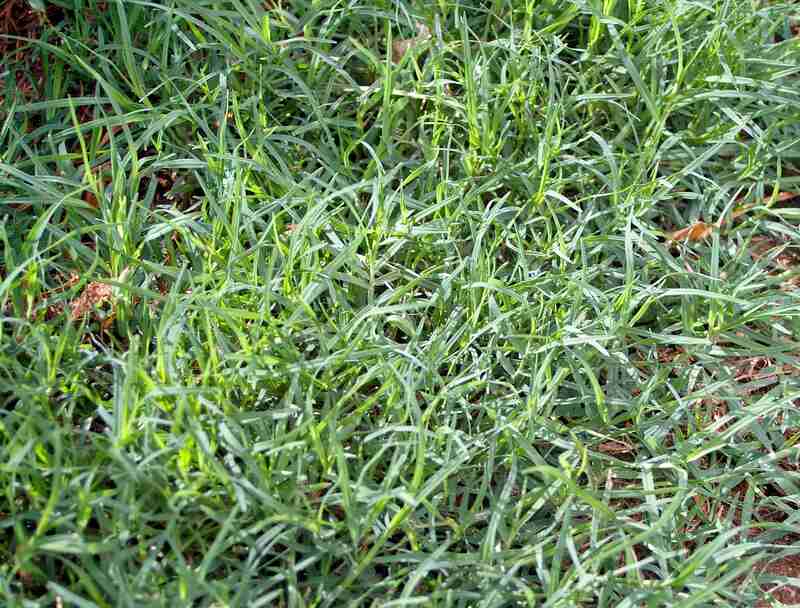
Photo Credit: Bidgee / Wikimedia Commons / CC BY-SA 3.0
A warm-season grass commonly found in the southern regions of the United States, bermudagrass is known for its fine texture, drought tolerance, and ability to grow in a wide range of soil types.
This fast-growing grass can quickly inhabit a new area. It has a high tolerance for heat and heavy foot traffic, making it an excellent choice for areas that receive a lot of sun and activity. That’s why it’s a popular choice not just for residential lawns but also for golf courses and sports fields across Atlanta.
Common bermudagrass may be a suitable choice for those looking for a grass type that has a coarser texture and requires less maintenance. However, for those who prefer a more refined and fine-textured grass, hybrid cultivars may be a better fit, although they require greater care and attention to maintain their appearance.
Classification: Warm-season grass
Spreads by: Stolons and rhizomes
Shade tolerance: Low – some varieties need more sun than others
Drought tolerance: High – may become dormant in long periods of drought
Foot traffic tolerance: High
Maintenance needs: Moderate to high – requires frequent watering, fertilization, and mowing to maintain its appearance and health
Recommended mowing height: 1-2 inches – raise the mower height during periods of drought or extreme heat
Potential for disease: Moderate – common diseases include dollar spot, large patch, leaf spot, and spring dead spot; can be prone to armyworms, bermudagrass mites, and nematodes
Soil pH: 6-6.5
Soil type: Grows in most soil types
Other notes: This grass species has the impressive ability to rapidly propagate itself. But this aggressive spreading also can be a double-edged sword, as it may result in the grass taking over and invading nearby flower beds or other cultivated areas.
2. Centipedegrass
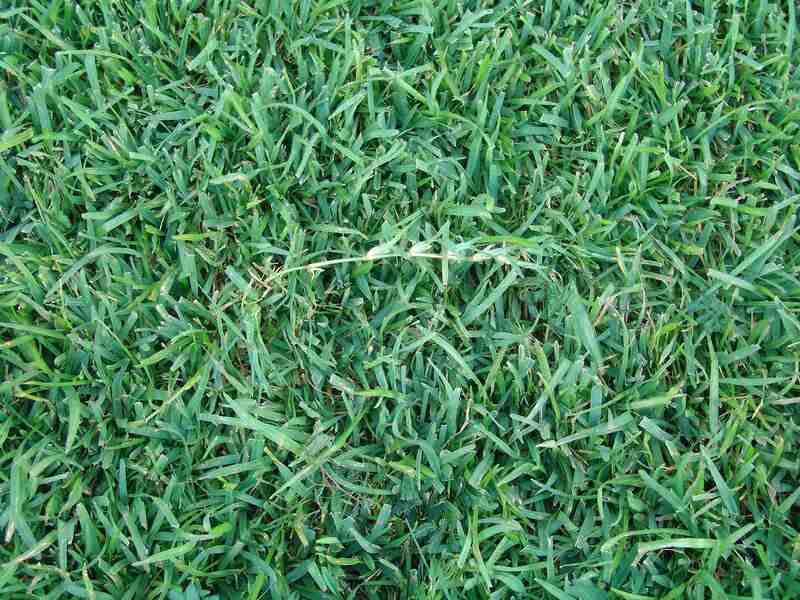
Photo Credit: James Becwar / Wikimedia Commons / CC0 1.0
With its low-growing, dense, and carpet-like appearance, centipedegrass is another popular choice for lawns across the southern United States. This low-maintenance, warm-season grass requires less water and fertilizer than other turfgrasses, making it a cost-effective option for homeowners who want a lawn that doesn’t require constant upkeep.
Centipedegrass prefers well-drained soils and partial shade. While it may not have the same deep green color as other grass varieties, centipedegrass does produce attractive seed heads that turn brown as they mature.
Classification: Warm-season grass
Spreads by: Stolons
Shade tolerance: Moderate – grows best in direct sunlight but can survive with as little as six hours of sun exposure a day
Drought tolerance: Low to moderate – may become dormant during extended periods of drought
Foot traffic tolerance: Low
Maintenance needs: Low – thrives even with minimal watering, mowing, and fertilization
Recommended mowing height: 1.5-2 inches – increase the mowing height by ½ inch if the area is shaded
Potential for disease: Moderate – mostly prone to iron chlorosis, centipedegrass decline, nematodes, ground pearl insects, spittlebugs, grubs, and lawn catterpillars
Soil pH: 5-6
Soil type: Acidic, infertile, and well-drained soils
Other notes: Avoid overfertilization and high nitrogen rates to lessen the risk of diseases and pest infestations.
3. St. Augustinegrass
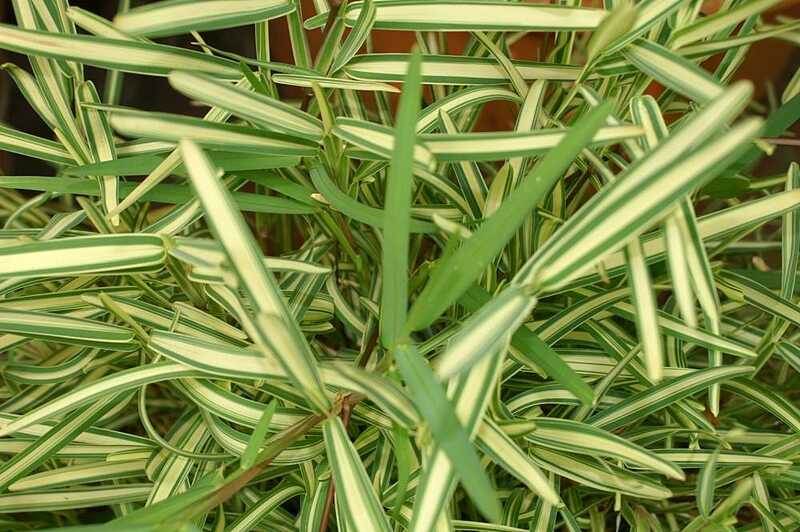
Photo Credit: David J. Stang / Wikimedia Commons / CC BY-SA 4.0
Known for its thick, lush, and coarse texture, St. Augustinegrass is another warm-season turfgrass that’s popular among homeowners in Atlanta. This grass variety thrives in hot and humid climates and is well-suited for coastal areas due to its tolerance for salt spray. It requires regular watering, fertilization, and mowing.
St. Augustinegrass prefers well-drained soils and sunny areas but also can tolerate partial shade. While it may not be as cold-tolerant as some other grass varieties, it can recover quickly from damage and has resistance to many common lawn diseases.
Classification: Warm-season grass
Spreads by: Stolons
Shade tolerance: Moderate – can handle partial shade
Drought tolerance: Moderate
Foot traffic tolerance: Moderate
Maintenance needs: Moderate to high – needs frequent watering, mowing, and fertilization
Recommended mowing height: 2.5-4 inches (mow dwarf cultivars from 2.5-3 inches, standard cultivars from 3-4 inches, mow tall in shade)
Potential for disease: Moderate to high – resistant to weeds and other common lawn diseases, but can be susceptible to nematodes, take-all root rot, chinch bugs, grass loopers, and cutworms
Soil pH: 6-7.5
Soil type: Well-drained, sandy soils
Other notes: Unlike other grass types, it doesn’t do well in compacted, clay soils
4. Zoysiagrass
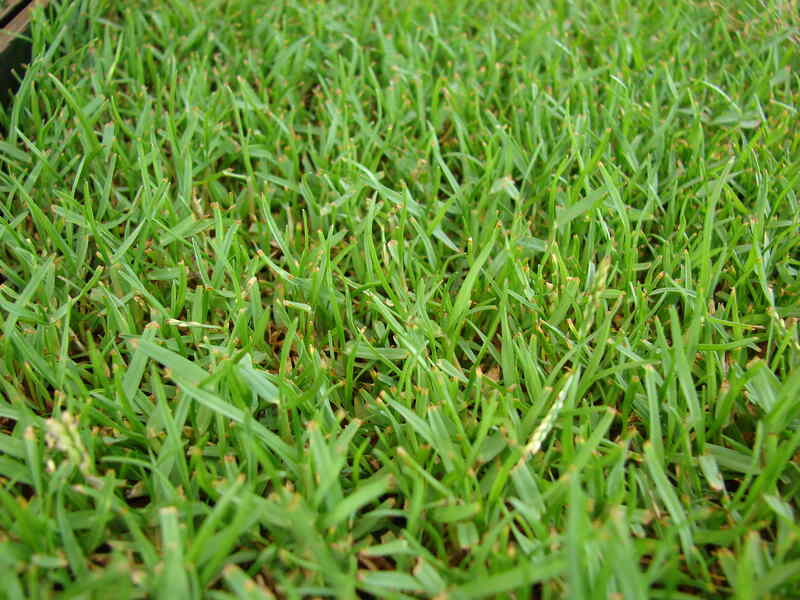
Photo Credit: Forest and Kim Starr / Flickr / CC BY 2.0
A warm-season turfgrass, Zoysiagrass is perfect for areas with low rainfall and humid summers like Atlanta. Known for its fine texture and dense, carpet-like appearance, this light green grass variety requires low to moderate maintenance – infrequent watering, fertilization, and mowing. It prefers being exposed to direct sunlight but can tolerate some shade.
Zoysiagrass is also known for its ability to spread rapidly through stolons and rhizomes, creating a thick and resilient turf. It’s not as cold-tolerant as other grass types, but it can quickly recover from damage.
Classification: Warm-season grass
Spreads by: Stolons and rhizomes
Shade tolerance: Low to moderate
Drought tolerance: High – although it needs supplemental watering during dry periods
Foot traffic tolerance: High
Maintenance needs: Low to moderate
Recommended mowing height: 1-2.5 inches
Potential for disease: Moderate – common diseases include fairy rings, dollar spot, brown patch, powdery mildew, pythium blight, rust, large patch, spring dead spot, leaf spot, root decline, chinch bugs, zoysiagrass mites, and mole crickets
Soil pH: 6-6.5
Soil type: Grows in most soil types but prefers well-drained soils
Other notes: Homeowners who love hosting BBQ parties in their yards prefer this grass variety for its resilience to foot traffic.
5. Kentucky Bluegrass
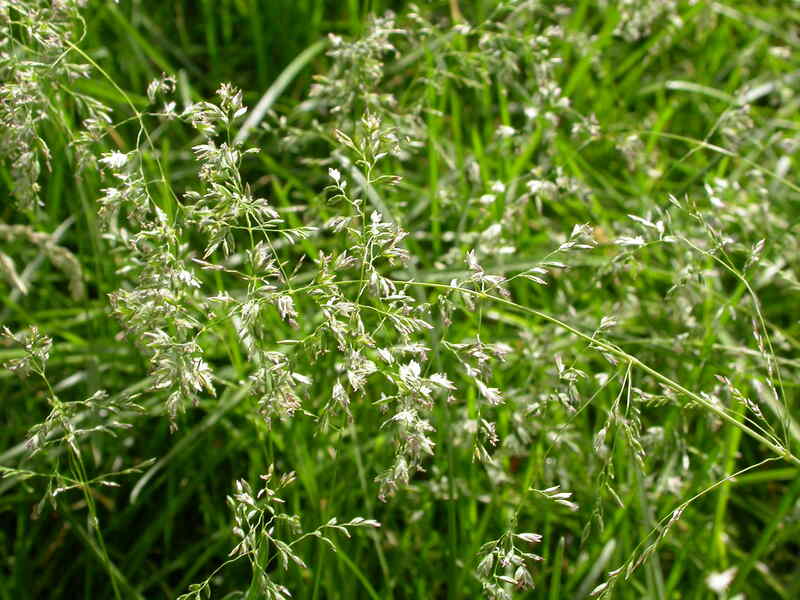
Photo Credit: Matt Lavin / Flickr / CC BY-SA 2.0
A cool-season grass, Kentucky bluegrass is known for its fine texture and rich bluish-green color. It flourishes exceptionally well in the cooler northern regions of Georgia, making it an ideal choice for residential properties, parks, sports fields, and golf courses in Atlanta.
This grass variety requires moderate maintenance, including regular watering, fertilization, and mowing. Kentucky bluegrass is also known for its ability to spread through underground rhizomes, creating a dense and resilient turf.
Classification: Cool-season grass
Spreads by: Rhizomes
Shade tolerance: Low to moderate – prefers full sun
Drought tolerance: Moderate
Foot traffic tolerance: Low to moderate, but recuperates well
Maintenance needs: Moderate
Recommended mowing height: 2-3 inches – mow taller during summer
Potential for disease: Moderate to high – can be prone to snow molds, summer patch, leaf spot, fairy rings, dollar spot, necrotic ring spot, chinch bugs, bluegrass billbugs, grubs, and greenbugs
Soil pH: 6-7
Soil type: Well-drained, fertile soils
Other notes: It’s most often mixed with other species, such as tall fescue, in home lawns. Due to its limited root depth, regular watering is necessary. Poor soil conditions and lack of water can cause diseases, but newer cultivars are generally hardier and more resistant to disease.
6. Perennial Ryegrass
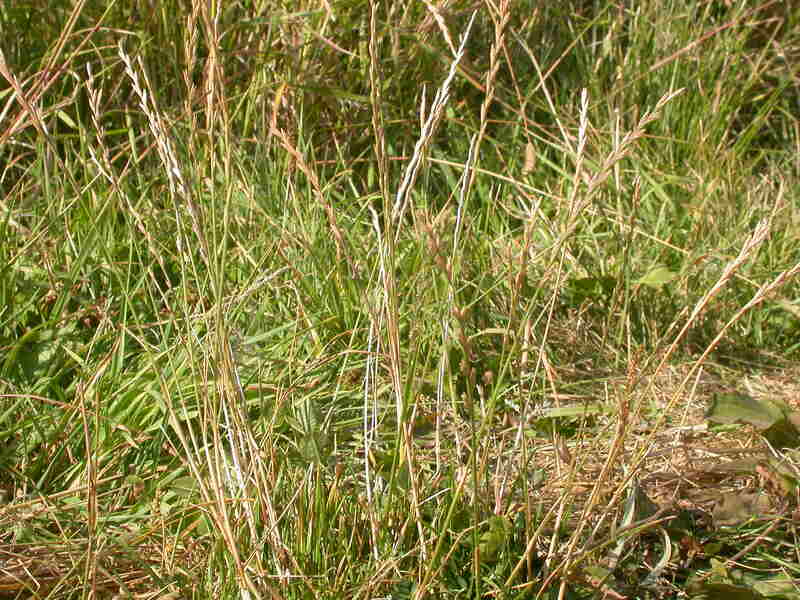
Photo Credit: Matt Lavin / Flickr / CC BY-SA 2.0
A cool-season grass, perennial ryegrass, grows best in the northern United States. This grass type has a fine texture, bright green color, and quick germination. It’s often used in overseeding practices for winter color in warm-season grasses.
Perennial ryegrass can establish quickly and produce a dense turf, making it a popular choice for high-traffic areas like sports fields. While it may not be as drought-tolerant as bermudagrass, perennial ryegrass is a versatile option for those looking for a lawn with a lush and vibrant appearance.
Classification: Cool-season grass
Spreads by: Tillers (Bunch forming)
Shade tolerance: Low – needs at least four to five hours under the sun
Drought tolerance: Low
Foot traffic tolerance: High – but recuperates poorly
Maintenance needs: High – needs frequent watering, mowing, and fertilization
Recommended mowing height: 2-3 inches
Potential for disease: High – susceptible to flag rust, stem rust, leaf spot, downy mildew, brown patch, red thread, chinch bugs, and greenbug aphids
Soil pH: 6-7
Soil type: Grows in most soil types but prefers well-drained, fertile soils
Other notes: Should you choose to overseed your warm-season grass with perennial ryegrass, maintain a proper balance of sunlight, moisture, and nutrients to lessen the risk of damage to your lawn.
7. Tall Fescue
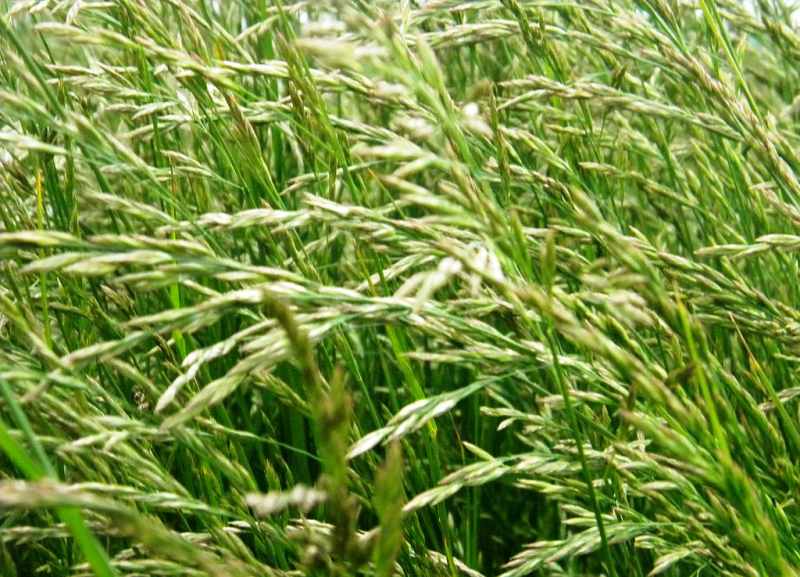
Photo Credit: Bildoj / Wikimedia Commons / CC BY-SA 3.0
Known for its deep green color and coarse texture, tall fescue is a popular choice for lawns in the central and eastern regions of the United States. This cool-season grass can tolerate a wide range of growing conditions, including drought, heat, and shade.
Tall fescue needs moderate upkeep, which entails regular watering, fertilizing, and mowing. This grass variety has a deep and extensive root system, which enables it to endure dry spells and periods of drought.
Classification: Cool-season grass
Spreads by: Tillers (Bunch forming)
Shade tolerance: Moderate to high
Drought tolerance: Moderate
Foot traffic tolerance: Moderate – doesn’t recover easily from wear
Maintenance needs: Moderate
Recommended mowing height: 2-4 inches (Check your cultivar and state recommendations, as many tall fescue lawns grow best when they’re mowed on the tall side.)
Potential for disease: Low to moderate – can be susceptible to brown patch, leaf spot, seedling disease, cutworms, armyworms, grubs, and sod webworms
Soil pH: 5.5-6.5
Soil type: Grows in most soil types but prefers clay soils
Other notes: Fertilize it only once in September and November. To restore the lushness of your lawn and address thinning and patchy areas, it is recommended to sow new grass seeds every few years.
FAQ About Atlanta Grass Types
If you want your lawn to be more pet-friendly, a grass variety that can withstand wear and tear, pet waste, and frequent paw traffic is essential. Bermudagrass and zoysiagrass are both popular options for pet-friendly lawns, as they are tough and can withstand the rigors of pet use.
A cool-season grass like tall fescue is typically the best choice for a shady lawn in Atlanta. This grass variety is well-suited for areas with limited sunlight and can tolerate shade better than warm-season grasses like bermudagrass or zoysiagrass.
If your lawn constantly gets heavy foot traffic, bermudagrass and tall fescue are good options, as they both have a deep root system that helps them withstand heavy use.
Centipedegrass and zoysiagrass are your best options for a low-maintenance lawn. Both are warm-season grasses that are well-adapted to the hot and humid climate of Atlanta, and they require less water, fertilizer, and maintenance than cool-season grasses like Kentucky bluegrass or perennial ryegrass.
Choosing Plant and Grass Varieties for Your Atlanta Landscape
While there are several grass types that grow well in Atlanta’s humid subtropical climate, each variety has its own unique benefits and drawbacks. Consider factors like sunlight, soil type, and maintenance requirements when selecting the right type of grass for your lawn.
Ultimately, the best grass for your landscape will depend on your specific needs, landscape plants, and preferences. Whether you opt for bermudagrass for its drought tolerance and rapid growth or St. Augustine for its lush, green appearance, the key is to give it proper care and attention. Enhance your home’s appeal and value with a healthy and vibrant lawn. Reach out to an Atlanta lawn care pro today.
Main Image Credit: Peakpx